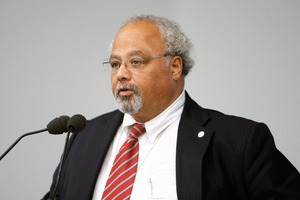Eric Goosby: Giving voice to the voiceless
A giant ribbon will not hang in front of the White House. No marches will be held. The lights on the Empire State building will not shine a special color. Instead, March 24th - World TB Day -is just like most any other day. Little attention will be paid to the fact that tuberculosis is now the number one infectious disease killer in the world.
TB has long been the stepchild of the three major global health diseases - AIDS, TB and malaria. A major reason why is that TB primarily impacts people living in poverty, those who are voiceless or whose voices are simply ignored. It is ironic that a curable disease remains a disease fighting to gain attention.
It is also ironic that at a time when Ebola and Zika have put our nation on notice about serious health threats, the same concern is not given to TB, which can spread like wildfire just by coughing. We need to look no further than Marion, Alabama to see how quickly TB can overwhelm a city. TB in Marion is now worse than in many developing nations.
According to the World Health Organization, 4,100 people die each day from TB - 1.5 million a year. TB is the most common cause of death among people living with HIV in sub-Saharan Africa. While 97% of TB cases respond to standard treatment, the world is not adequately confronting the increasing resistance to TB drugs. The incidence of multi-drug resistant tuberculosis (MDR-TB), a form of TB caused by bacteria that do not respond to standard, first-line anti-TB drugs, is growing. MDR-TB is treatable and curable by using second-line drugs. However, second-line treatments are limited and may not always be available or, if available, are cost prohibitive. Today, only 25% of MDR- TB patients are diagnosed and treated and only 50% of these patients are treated successfully.
It is important to note that there has also been great progress in the fight against TB.
Incidence has fallen by an average of 1.5% per year since 2000 and is now 18% lower than the level of 2000. The TB death rate dropped 47% between 1990 and 2015. And an estimated 43 million lives were saved through TB diagnosis and treatment between 2000 and 2014.
It is clear that we can turn the tide, but not without the contributions of the U.S., other donor nations and the private sector. Currently, nations burdened by TB contribute 87% of the total budget to tackle the disease. While these countries know they can’t do it alone, they are not running away from the problem either. They have skin in the game and it is now time for the U.S. and other nations to increase their investments.
Last month, the Obama Administration proposed a 19% cut in TB funding. As a former Global AIDS Coordinator in this Administration I recognize how difficult it is to balance competing domestic and global needs. And I praise President Obama for his commitment to global health, especially during tough economic times. Yet, with TB now taking the most lives around the globe, I remain puzzled by the size of this year’s cut to critical TB programs. It is not just the size of the cut. It is the magnitude of the impact.
All eyes now turn to Congress. Fortunately, members from both sides of the aisle have historically recognized that TB interventions are the most cost effective interventions in global health. TB interventions have up to a $43 return for every dollar invested. That’s a good buy for the American people and good protection from TB crossing our borders and posing a serious health threat.
It is once again up to Congress to make needed investments in testing and treatment and research and development. Congress has the ability to turn the tide and rid the world from TB. We have the cure, we now need the political will. And if the past is prologue, our nation will give voice to the voiceless and help make our world TB-free.
Eric Goosby is the UN special envoy on tuberculosis
Source: The Huffington Post


